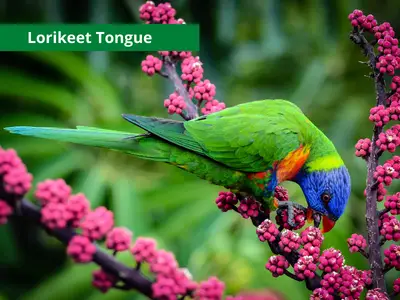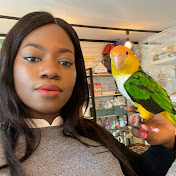
Lorikeet Tongue: Rare Anatomy And Functions Explained!
Lorikeet Tongue is a wonder because it has rare anatomy that is quite different from other parrot tongues.
There are a lot of questions people may have about the lorikeet tongue just like the cockatoo tongue.
In this blog post, we will take time to share all the information you may want to know about the lorikeet tongue, its anatomy, and how it functions.
Lorikeet specifically, belongs to the Loriini tribe, which includes their close cousins, the lories. Between the two, there are roughly 60 species, with about 40 of those being lorikeets.
It’s the Trichoglossus genus that includes the popular rainbow lorikeet, which is one of the most common lorikeets.
They include Vini, Glossopsitta, Parvipsitsitta, Charmosyne, and Neopsittacus of the lorikeet genus. However, a few of these are routinely kept as pets!
It’s common to see lorikeets in all of Australasia. The most well-known lorikeet species, the rainbow lorikeet, hails from Australia, although others can be found in Indonesia, New Guinea, and a slew of other islands.
Lorikeets come in a wide variety of sizes and colors. Rainbow lorikeets are ubiquitous and popular in their native region, with many people putting out feeders to attract them.
The food of Australasian parrots is unique, and the birds have adapted to thrive on it. In the parrot world, this has made the lorikeet tongue unique, and it’s also what makes lories and lorikeets more difficult to care for as pets.
Do Lorikeets Have Tongue?
Yes, lorikeets do have a tongue, the only difference here is that the tongues are slightly different from the usual tongues observed in most birds. Lorikeet’s tongues are brush-like and have over time evolved to be suitable for sipping saps and nectar out of plants.
Lorikeet Tongue
Lorikeets have bristle-like tongues that they use to clean themselves. Lorikeets don’t eat seeds, unlike many other parrots. In fact, seeds are harmful to them. To get nectar and pollen, it utilizes a bristle brush tongue to sift through the petals of local flowers.
Because they feed on nectar and pollen, lorikeet (and lory) species have developed long, flexible tongues to help them get at it. The ‘brush’ on the tip of the tongue helps them get the most flavor out of their favorite flowers, namely Eucalyptus.
Some lorikeet owners have reported that their noses and ears have been mistaken for flowers from time to time. A lorikeet owner must be prepared to deal with a bird’s tongue poking out of their ear at the most inconvenient times.
Lorikeet Tongue Anatomy And Functions
Scanning electron microscopy was used to analyze the lingual surfaces of rainbow lorikeets (Trichoglossus haematodus). The rainbow lorikeet’s tongue looks like a finger when viewed under a microscope.
The apex, body, and root of the tongue can all be seen on the tongue’s dorsal surface. Multiple processes are inclined toward the medial side of the tongue from the lateral side at the apex. Rod-like structures and smooth surfaces characterize these procedures.
The lingual body has several grooves on both the left and right sides. The lingual gland has a huge aperture in the middle of the lingual root, as well as large holes on both sides of the lingual root.
Lorikeets have one of the rare tongue formations among other birds. It is a marvel to see how lorikeet tongues are designed to suit them perfectly.
The anatomy of the lorikeet tongue is one that definitely needs time and effort to study and understand.
Lorikeets have diets that are very unusual in the parrot world, no wonder their tongues have evolved to adapt perfectly to their type of diet. This tongue evolution has made their tongue stand out from other tongues among birds and parrots.
Lorikeet’s tongues are long and flexible. The tip of the tongues has a feature that is brush-like and this feature helps them to access the best part of their favorite flowers.
Do Lorikeets Have Spiky Tongue?
Yes, lorikeets can be said to have a spiky tongue, although spiky may not be the best word to describe their appearance. It is more like a soft brush-like tongue and the brush-like part is located on the tip of the tongue.
Lories and lorikeets have this distinct tongue anatomy because it is designed specifically to suit their diet. On the tip of the tongue are papillae that give it a brush-like appearance. Helps in the acquisition of food.
Unlike lorikeets other birds have tongues with spines covering the majority of the tongue and even the roof of their mouths, making it difficult to swallow. There are prickly spikes on their bill as well. These birds are able to catch and hold on to fish because of the ridges and spines on their bodies.
Lorikeet Diet and Their Tongue’s Adaptation
Floral nectar, pollen, and/or soft foods like fruits make up the bulk of the typical lorikeet’s diet. In reality, these pests can be a major issue for farmers and orchard owners in their own countries. They have a particular fondness for swoops and swoops and swoops.
Nectar and pollen aren’t the only things lorikeets and lories eat, but it does make up a significant portion of their diets.
Soft fruits like figs, hibiscus, and coconut are among the other items they’ll eat. Some types of seeds, insects, and their larvae are also eaten by them.
With a bird feeder, you can attract lorikeets to your garden if you live in a region where they are naturally found (or were introduced, like in Hong Kong).
Feeding bread, honey, jam, and other sugary “human food” to lorikeets will not keep them healthy. Instead, it may cause health issues for them, so it is better to avoid feeding
One of the nicest things you can do for your yard is to plant native bushes and trees, like the popular eucalyptus or bottlebrush.
Pet lorikeets can be fed commercial lorikeet food, as well as fresh fruits and vegetables. Also, don’t forget to bring plenty of clean, fresh water.
What Does Rainbow Lorikeet Tongue Look Like?
Rainbow Lorikeets have bristle-tipped tongues. In contrast to many other birds, the lorikeet does not eat seeds. Because its bristle brush tongue extracts nectar and pollen from deep within native flowers, it is unable to utilize its beak.
Why Do Lorikeets Have Brush-like Tongues?
Lorikeets have brush-like tongues because they feed on nectar and pollen, lorikeet (and lory) species have developed long, flexible tongues to help them get at it. For the tastiest parts of their favourite flowers, like Eucalyptus, they have a ‘brush’ on the tip of their tongues.
Why Do Rainbow Lorikeets Lick?
This aids them in obtaining food. To learn more about your hands, lories, and lorikeets often use their tongues. If you have nectar on your fingers, they’ll lick it off of your hands.
Conclusion
Lorikeet tongue is one of the strangest and oldest tongues in its family. Their tongues have evolved over time to be able to fit their feeding and diet styles. Unlike other birds that feed on pollens and seeds, Lorikeet has a different feeding system and they also have a different feed that is not usual with other common birds which was the reason for their brush-like tongue appearance.
If there is other information you need to know, let me know via the comment section below.

Hi, I am Thersa and Welcome to ParrotKeen, your number one place to get all the information you need about your cute parrot. I hope You Find it useful.
